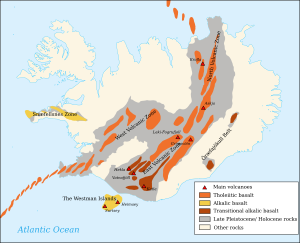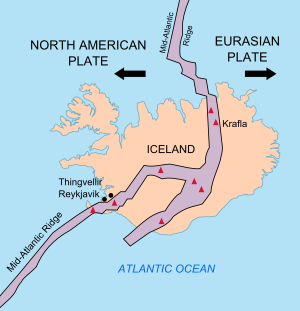Iceland hotspot facts for kids
The Iceland hotspot is a special place deep under the Earth's surface. It helps explain why the island of Iceland has so many volcanoes and a lot of volcanic activity.
Iceland is one of the most active volcanic places on Earth. Volcanoes erupt there about every three years! In the 1900s, there were 39 volcanic eruptions on and around Iceland. A huge amount of the lava that has erupted in recorded history came from Iceland. This lava is a type called basalt.
Some very big eruptions have happened in Iceland. For example, the Eldgjá eruption in 934 was the largest basalt eruption ever seen. It came from a long crack in the ground near the Katla volcano. Another huge eruption was Laki in 1783, which was the second largest.
Much of Iceland is covered by glaciers. Sometimes, volcanoes erupt under these thick ice caps. When this happens, the eruption can burst through the ice. A recent example was in 2010, when the Eyjafjallajökull volcano erupted.
Iceland's location over the Mid-Atlantic Ridge also causes its intense volcanic activity. The Mid-Atlantic Ridge is where two of Earth's huge plates are pulling apart. Scientists are still trying to understand why Iceland is a large island, while most of the rest of this ridge is underwater.
What Causes the Iceland Hotspot?
Scientists are still discussing what causes the Iceland hotspot. They wonder if it comes from a very deep mantle plume. A mantle plume is like a giant column of hot rock rising from deep inside the Earth. Or, it might be caused by something closer to the surface.
Some geologists wonder if the Iceland hotspot is like other famous hotspots, such as the Hawaii hotspot. The Hawaii hotspot leaves a clear trail of volcanoes as the Pacific Plate moves over it. But at Iceland, it's harder to see such a clear trail.
However, some lines of volcanoes might show how the Earth's plates are moving. For example, the line from the Grímsvötn volcano to Surtsey might show the movement of the Eurasian Plate. And the line from Grímsvötn to the Snæfellsnes volcanic belt could show the movement of the North American Plate.
Images for kids
See also
 In Spanish: Punto caliente de Islandia para niños
In Spanish: Punto caliente de Islandia para niños






